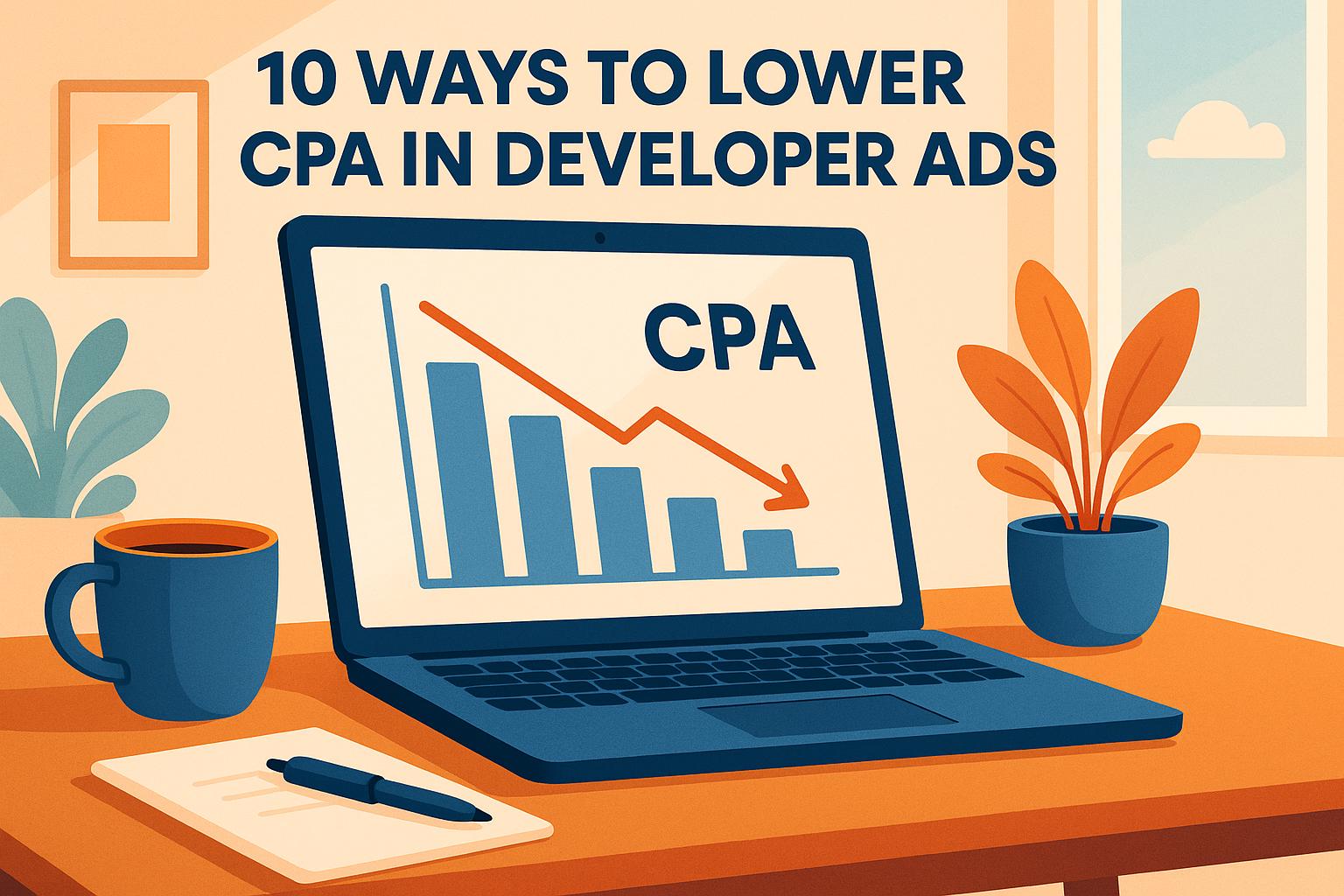


Explore why traditional MQLs fail in developer marketing and how a contributor-focused strategy drives meaningful engagement and success.
The traditional MQL (Marketing Qualified Lead) model doesn't work for developer marketing. Developers don't respond to flashy promotions or sales tactics - they rely on hands-on experience, community interactions, and technical resources. This article explains why shifting from MQLs to a contributor-focused strategy is critical for engaging developers and measuring meaningful success.
Key Takeaways:
- Why MQLs fail for developers: Developers prefer exploring tools collaboratively, often through documentation, forums, and APIs - actions that MQLs don't track effectively.
- Contributor-focused approach: Success is measured by active participation, like code contributions, community engagement, and deep product adoption.
- Developer journey stages: From awareness to contribution, each phase requires tailored technical content, hands-on resources, and community support.
- Better metrics for success: Focus on community engagement, contributor growth, product adoption depth, and developer sentiment to measure impact.
This shift prioritizes long-term relationships and community building over quick lead generation, aligning with how developers evaluate and adopt technology.
Why Developers Ignore Your Marketing – And What to Do About It
How Developers Move from Awareness to Contribution
Mapping out how developers transition from discovering your platform to actively contributing to it is key to understanding their journey. This progression redefines success in developer marketing by highlighting the motivators and obstacles developers face along the way.
The Developer Engagement Funnel
The developer engagement funnel is broken down into five stages, each requiring tailored content strategies to guide developers effectively.
Awareness is the starting point, where developers first learn about your platform. This might happen through technical blogs, community discussions, or recommendations from colleagues. At this stage, clear and concise technical content is essential. Focus on publishing blog posts and maintaining an active presence on platforms like Stack Overflow, GitHub, and Reddit tech communities.
Interest begins when developers show genuine curiosity about your platform and start exploring your resources. Here, the quality of your information is critical - 52% of developers cite it as one of their top priorities. Offer engaging newsletters, interactive posts, and content that deepens their understanding of your platform.
Evaluation is the phase where developers put your platform to the test, often comparing it to other solutions. This stage demands hands-on experiences, such as tutorials, sample code, sandbox environments, and free trials. Provide in-depth product guides, case studies, and feature comparisons that showcase what sets your platform apart. When developers begin using your tools, it’s a strong indicator they’re considering long-term integration.
Adoption happens when developers integrate your platform into their workflows and start building with it. To support this, offer robust developer tools, SDKs, APIs, and real-time assistance. High-quality documentation is especially critical here, as developers rely on it to successfully implement your solution.
Contribution is the ultimate milestone, where developers become active members of your community. They might contribute code, answer questions, or create content. To encourage this, provide case studies and templates that help developers advocate for your platform within their organizations. Promote knowledge sharing to enhance team productivity.
What Motivates Developers and Common Barriers
Understanding the stages of this funnel sheds light on what drives developers and the challenges they face. Developers are often motivated by opportunities to learn and tackle interesting technical problems. High-quality information, such as advanced technical resources, integration guides, and detailed case studies, plays a crucial role in engaging them.
However, several barriers can slow or stop their progress through the funnel. These include a lack of trust, inaccessible technology, and limited awareness of how to participate or contribute. Poorly designed platforms can also deter engagement, as developers prefer user-friendly interfaces.
Organizational challenges, such as bureaucracy, poor management, and lack of work-life balance, can further hinder engagement. Remote work challenges, burnout, rapid technological changes, and managing diverse teams add to these difficulties.
To address these obstacles, focus on transparency and delivering value. Show developers that their input matters by engaging in meaningful consultations and actively incorporating their feedback into your platform. Provide clear, accessible information and foster an environment that encourages growth, creativity, and collaboration. By doing so, you can build trust and create a space where developers feel empowered to contribute.
Better Success Metrics for Developer Marketing
When it comes to developer marketing, relying on traditional metrics like MQLs (marketing-qualified leads) or website traffic simply doesn’t cut it. These standard measurements fail to reflect how developers interact with products and communities. To create campaigns that resonate and drive meaningful engagement, it’s essential to focus on metrics that align with developer behavior. Let’s dig into what these metrics look like and why they matter.
Metrics That Actually Matter
Measuring success in developer marketing requires a shift in perspective. Unlike traditional marketing, which prioritizes quick wins and lead volume, developer marketing emphasizes long-term relationships and the overall health of the community.
Community engagement is a cornerstone metric. It’s not about how many people show up, but how they interact. Think active participation in forums, contributions to GitHub repositories, sharing knowledge in documentation, or even helping peers troubleshoot issues. Quality trumps quantity here - what matters is the depth of these interactions and how developers collaborate and support one another.
Contributor growth tracks how many developers move from passive users to active participants. These are the folks who submit code, write tutorials, answer questions, or even champion your platform within their own networks. This transformation isn’t instant - it often takes months or years - but it’s a much more meaningful indicator of success than simply counting leads.
Product adoption depth goes beyond surface-level metrics like sign-ups or downloads. It measures how deeply developers integrate your tools into their workflows. This might include analyzing API usage, tracking which features are being utilized, or assessing the complexity of their implementations. When developers use your product in advanced ways, it shows they’re finding real value - and are more likely to stick around.
Developer sentiment captures the qualitative side of your efforts. By monitoring mentions in developer forums, tracking social media conversations, and collecting survey feedback, you can gauge how developers feel about your product. Positive sentiment often leads to organic advocacy - developers recommending your tools to others, which is a powerful driver of growth.
One thing to keep in mind: developer marketing success takes time. While traditional marketing often focuses on short-term ROI, only a small percentage of developer marketing campaigns are evaluated over periods longer than six months. Building trust and fostering contributions within a developer community requires patience and a long-term outlook.
Standard vs. Contributor-Focused Metrics Comparison
To highlight the differences between traditional marketing and developer-focused approaches, here’s a side-by-side comparison:
| Aspect | Standard Marketing Metrics | Contributor-Focused Metrics |
|---|---|---|
| Primary Focus | Lead volume and quick conversions | Community health and long-term engagement |
| Success Indicators | MQLs, website traffic, form submissions | Active contributors, code commits, community participation |
| Measurement Timeline | 1-3 months | 6-18 months |
| Relationship Depth | Surface-level interest | Deep product integration and advocacy |
| Revenue Connection | Direct sales attribution | Indirect impact through community growth and retention |
| Developer Behavior | Treats developers like typical consumers | Recognizes developers' analytical and technical nature |
Traditional metrics can be misleading when applied to developer marketing. For example, a high number of MQLs might look good on paper, but these leads often fail to convert because developers tend to avoid pushy sales tactics. Developers prefer to explore and evaluate products independently, taking their time to test and understand their options.
Contributor-focused metrics, on the other hand, align with how developers operate. This approach acknowledges the need for time - time to experiment, build trust, and integrate solutions. By focusing on developer-specific engagement, you get a clearer view of long-term success.
The tools used to measure these metrics are also different. While traditional marketing leans heavily on CRM systems and lead scoring, developer marketing requires tools that track activity in code repositories, monitor community forums, and analyze engagement with technical content. Platforms like daily.dev Ads cater specifically to developer audiences, allowing campaigns to be measured based on developer-specific behaviors rather than traditional conversion funnels.
sbb-itb-e54ba74
How to Drive Developer Engagement and Contributions
Turning developers from passive observers into active contributors takes a thoughtful approach that aligns with their values and work habits. Unlike typical marketing audiences, developers appreciate honesty, practical solutions, and genuine community involvement. Building trust through clear communication and creating opportunities for meaningful participation are essential steps in this process.
Using Targeted Campaigns on Developer Platforms
To connect with developers effectively, meet them where they already are. The best campaigns focus on platforms that developers rely on daily, integrating seamlessly into their routines instead of pulling them away from their workflow.
For example, daily.dev Ads offers native ad placements that blend naturally into developers' content consumption habits. With over 1 million developers in its ecosystem, this platform allows precise targeting based on factors like seniority, programming languages, and tools. This approach works because ads that appear in a developer's technical environment are much more effective.
Authenticity is critical. Campaigns that showcase real-world code examples perform better than those with abstract promises. Developers, who often approach advertising with skepticism, value straightforward information about how a product can address their specific challenges.
Transparency also matters. Research shows that 70% of people value transparency more than ever. This is especially true for developers, who tend to do thorough research before making decisions. Messaging should highlight both strengths and limitations. As one developer, Frost1x, put it:
"Give me a fair assessment of something without BS… Developers trust other devs because other devs tend to give you this information and don't paint everything as rosy perfection."
Developer-focused platforms also allow for highly personalized communication. With 91% of consumers more likely to engage when messaging is tailored to them, segmenting audiences by interests, experience levels, or technology stacks can make a significant impact.
This targeted approach lays the groundwork for creating valuable content that resonates with developers.
Building Content That Provides Real Value
Once you've reached developers on the right platforms, the next step is to engage them with content that they find genuinely useful. For developers, this means shifting away from promotional messaging and focusing on resources that provide practical knowledge they can apply immediately.
Content like tutorials, documentation, and interactive examples can address real-world problems, showcase capabilities, and help developers build new skills.
Educational resources such as webinars, tutorials, and whitepapers are excellent tools for engaging developers. Interactive formats - like code samples, demos, or hands-on workshops - allow developers to experiment directly with tools, building confidence and familiarity.
Collaborating with respected members of the developer community or internal experts can amplify the credibility and reach of your content. When trusted voices contribute to or endorse your resources, developers are more likely to engage.
Recognizing and Rewarding Community Participation
Recognition plays a vital role in keeping developers engaged over the long term. When you acknowledge contributions, you validate the effort and expertise developers bring to the table, fostering a positive community atmosphere.
Be specific in your recognition - highlight individual technical contributions like code commits or insightful forum posts. This shows developers that their unique skills and efforts are valued.
Gamification elements, such as leaderboards and badges, can add a fun, competitive edge to community participation. However, these should enhance, not replace, meaningful recognition.
Offering exclusive access opportunities, like early access to new features or invitations to beta testing, can also motivate participation. These rewards appeal to developers' desire to stay ahead in technology and contribute to shaping products.
Timely feedback is another key factor. Prompt, detailed responses to contributions encourage ongoing engagement and show developers that their efforts are noticed. Involving the community in the recognition process - through nominations or voting for outstanding contributions - further strengthens bonds and creates a sense of mutual appreciation.
Balancing intrinsic motivators, like the chance to learn and solve interesting problems, with tangible rewards, such as exclusive perks, is essential for turning casual participants into committed contributors. Through open-source projects, mentorship programs, or structured challenges, developers can find clear and rewarding paths to deeper involvement.
Matching Marketing Efforts with Developer Preferences
To effectively shift from traditional Marketing Qualified Leads (MQLs) to a contributor-driven strategy, it’s crucial to align marketing efforts with what developers truly value. With a global community of over 27 million developers, dominated by millennials (about 65% of the group), their preferences lean heavily toward functionality, efficiency, and technical precision. Flashy promotions won’t cut it here - marketers need to tailor their strategies to these specific priorities.
Creating Messages and Content That Resonate
When it comes to developer marketing, authenticity and clarity are non-negotiables. Developers face unique challenges every day, and they gravitate toward messaging that offers real solutions. This means ditching buzzwords and empty slogans in favor of transparent, technically accurate communication.
"Your value proposition is more than just a catchy phrase - it's the core of why someone should care about your product. It distills the benefits, the differentiation, and the outcomes into something that customers immediately understand and find compelling. It answers the question: 'Why should I choose this product over any other?'" - Tracy Evans, B2B Brand Positioning: Frameworks and Strategies for Success
Developers prefer content that simplifies complex tasks and addresses practical problems. They aren’t looking to be “sold to” - instead, they want to learn, experiment, and evaluate. Highlight your product’s technical capabilities with specific examples, step-by-step implementation guides, and measurable results.
Using precise, technical language not only demonstrates your expertise but also builds trust. Since many developers prefer to “try before they buy”, offering trials or beta access allows them to experience your product firsthand, which can be far more persuasive than any pitch.
Once your messaging is solid, you’ll need to focus on targeting the right audience with the same level of precision.
Advanced Targeting and Measurement Best Practices
Developer-focused marketing thrives on detailed targeting and accurate measurement. Unlike broad consumer campaigns, successful developer outreach hinges on segmentation that’s based on technical expertise and professional context.
Platforms like daily.dev Ads excel at this by offering segmentation options based on programming language, seniority, or organization type. This ensures your ads are seen by developers who are most likely to engage with your product.
Contextual targeting further boosts relevance. For example, an ad for a Python library will perform significantly better when shown to developers actively consuming Python-related content rather than general tech updates. This kind of alignment between content and audience interests leads to higher engagement and better conversions.
When it comes to measuring success, traditional click-through rates may not tell the whole story. Developers often take their time, conducting thorough research before making decisions. Metrics like view-through conversions and longer attribution windows can provide a more accurate picture of your campaign’s impact.
Multi-touch attribution is another key factor. Developers might see your ad, explore your documentation, join your community forum, and download a trial - all before converting. Understanding how these touchpoints work together helps identify which interactions drive the most value.
Email marketing also remains a strong channel, with nearly 40% of developers clicking links in newsletters. Combining email outreach with other touchpoints ensures you’re providing value at every step of the journey, rather than pushing for an immediate sale.
Short-Term vs. Long-Term Engagement Methods
Balancing short-term goals with long-term strategies is essential in developer marketing. Here’s a quick breakdown of methods for both approaches:
| Approach | Timeline | Methods | Benefits | Limitations |
|---|---|---|---|---|
| Short-Term | 1–3 months | Paid ads, demos, trials, webinars | Quick leads, fast ROI, rapid testing | Higher costs, limited trust, less community impact |
| Long-Term | 6–24 months | Open-source projects, community building, educational content | Builds trust, lowers acquisition costs, drives sustainable growth | Slower results, harder to measure ROI, requires ongoing investment |
Short-term methods are great for generating leads quickly and validating market interest. Paid ads, time-limited trials, and webinars can deliver fast results, especially when launching new features or entering new markets. However, developers tend to be skeptical of overtly promotional content. They value peer recommendations, user reviews, and data-driven insights, so short-term tactics work best when they offer immediate, tangible benefits.
On the flip side, long-term engagement focuses on fostering relationships and building trust. By contributing to open-source projects, creating educational resources, and nurturing a developer community, you can establish a solid foundation for sustained growth. Developers who actively engage with your community often become advocates, sharing authentic recommendations that carry significant weight.
The most effective strategies combine both approaches. Use short-term campaigns to capture immediate attention and generate leads, while investing in long-term initiatives to build credibility and trust. This dual focus ensures you’re not only meeting immediate goals but also laying the groundwork for lasting success.
Conclusion: A New Way to Measure Developer Marketing Success
The move away from traditional Marketing Qualified Leads (MQLs) toward contributor-focused metrics marks a major change in how success in developer marketing is defined. The numbers say it all: only 2% of MQLs convert, compared to a much higher 25-30% conversion rate for Product Qualified Leads (PQLs) - an eightfold difference. This striking gap makes it clear that it’s time to rethink how we measure success.
MQLs often fail to capture what really matters in developer marketing. As Monica Behncke puts it:
"To evolve marketing measurement, we need to redefine MQLs and MQAs as inputs rather than outcomes".
The problem with MQLs is that they only reflect surface-level engagement, not genuine buying intent. Developers, who tend to rely on hands-on experience and peer recommendations, are not well-served by this outdated metric.
To truly measure success, we need to focus on metrics that align with developer behavior. Metrics like pipeline generation, Customer Acquisition Cost (CAC), and marketing-influenced revenue offer a clearer picture of what’s working. These indicators highlight prospects who have shown real interest through meaningful actions - whether that’s contributing code, engaging in community discussions, or actively using your product.
Platforms like daily.dev Ads make this shift easier by offering precise targeting based on programming language, seniority, and technical interests. With access to over 1 million engaged developers, the platform allows marketers to connect with contributors who are already interacting with relevant content. This makes every interaction more purposeful and conversion-focused.
But targeting alone isn’t enough. Long-term success also depends on building authentic relationships within developer communities. Winning strategies combine technical accuracy, genuine community participation, and a focus on sustained engagement over quick wins. When developers transition from users to active contributors in your ecosystem, they evolve into advocates - driving organic growth that traditional metrics simply can’t capture.
Shifting away from MQLs means turning your attention to what truly matters: pipeline quality, community engagement, and contributor growth. By aligning your measurements with the way developers make decisions, you can move beyond superficial leads and build a foundation for lasting success. This approach not only respects developer behavior but also sets the stage for meaningful contributions that fuel sustainable growth.
FAQs
Why doesn’t the traditional MQL model work for developer marketing, and what metrics are better for measuring success?
The old-school MQL (Marketing Qualified Lead) model doesn't quite hit the mark when it comes to developer marketing. Why? Because it focuses too much on gathering leads and not enough on creating genuine connections or fostering a sense of community - both of which are crucial in developer ecosystems. Developers tend to value authenticity and collaboration, so a lead-driven approach often misses the mark.
To truly resonate with developers, success should be tracked using metrics that highlight real engagement and long-term value. Key metrics to focus on include active users, interaction with documentation, product adoption rates, Net Promoter Score (NPS), and developer contributions to the community. These metrics better align with how developers interact and engage, allowing marketers to build stronger, more meaningful relationships over time.
How can companies guide developers from initial awareness to active participation in their communities?
To move developers from simply being aware of your company to actively participating, focus on building genuine relationships and fostering meaningful interactions. Begin by establishing trust - this means being transparent, open to communication, and genuinely listening to what developers need or suggest. Acknowledge their efforts and celebrate their achievements to make them feel appreciated and valued.
Encourage involvement by providing clear and accessible ways to collaborate. This could include hosting hackathons, organizing events, or inviting participation in open-source initiatives. Create a community that prioritizes respect, support, and inclusivity, ensuring developers feel like they belong. When you align your approach with what developers care about most, you can cultivate stronger bonds and inspire them to contribute in lasting and impactful ways.
What challenges do developers face when engaging with new platforms, and how can these be overcome to build stronger community connections?
Developers often face hurdles such as resistance to change, unclear advantages of adopting new tools, workflows that don't fit their processes, and struggles to gain organizational backing. These challenges can make them hesitant to embrace new platforms.
To overcome these barriers, it's essential to emphasize tangible benefits that align with developers' objectives, provide tailored onboarding experiences to make the transition smoother, and foster community-driven initiatives that promote collaboration and shared learning. Building trust through open communication and consistent transparency can also go a long way in encouraging lasting engagement.






